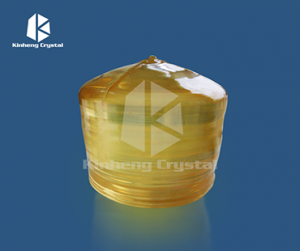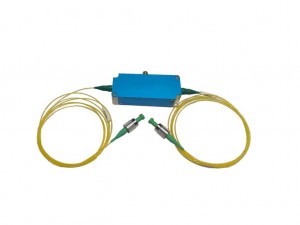GGG Substrate
Description
Gallium Gadolinium Garnet (Gd3Ga5O12 or GGG) single crystal is material with good optical, mechanical and thermal properties which make it promising for use in fabrication of various optical components as well as substrate material for magneto-optical films and high–temperature superconductors.It is the best substrate material for infrared optical isolator (1.3 and 1.5um), which is a very important device in optical communication. It is made of YIG or BIG film on the GGG substrate plus birefringence parts. Also GGG is an important substrate for microwave isolator and other devices. Its physical, mechanical and chemical properties are all good for the above applications.
Properties
|
Crystal Structure |
M3 |
|
Growth Method |
Czochralski method |
|
Unit Cell Constant |
a=12.376Å,(Z=8) |
|
Melt Point(℃) |
1800 |
|
Purity |
99.95% |
|
Density(g/cm3) |
7.09 |
|
Hardness (Mho) |
6-7 |
|
Index of Refraction |
1.95 |
|
Size |
10x3,10x5,10x10,15x15,,20x15,20x20, |
|
dia2” x 0.33mm dia2” x 0.43mm 15 x 15 mm |
|
|
Thickness |
0.5mm,1.0mm |
|
Polishing |
Single or double |
|
Crystal Orientation |
<111>±0.5º |
|
Redirection Precision |
±0.5° |
|
Redirection the Edge |
2°(special in 1°) |
|
Angle of Crystalline |
Special size and orientation are available upon request |
|
Ra |
≤5Å(5µm×5µm) |
GGG Substrate Definition
GGG substrate refers to a substrate made of gadolinium gallium garnet (GGG) crystal material. GGG is a synthetic crystalline compound composed of the elements gadolinium (Gd), gallium (Ga) and oxygen (O).
GGG substrates are widely used in magneto-optical devices and spintronics due to their excellent magnetic and optical properties. Some key properties of GGG substrates include:
1. High transparency: GGG has a wide range of transmission in the infrared (IR) and visible light spectrum, suitable for optical applications.
2. Magneto-optical properties: GGG exhibits strong magneto-optical effects, such as the Faraday effect, in which the polarization of light passing through the material rotates in response to an applied magnetic field. This property enables the development of various magneto-optical devices, including isolators, modulators, and sensors.
3. High thermal stability: GGG has high thermal stability, which enables it to withstand high temperature processing without significant degradation.
4. Low thermal expansion: GGG has a low coefficient of thermal expansion, making it compatible with other materials used in device fabrication and reducing the risk of failure due to mechanical stress.
GGG substrates are commonly used as substrates or buffer layers for the growth of thin films or multilayer structures in magneto-optical and spintronic devices. They can also be used as Faraday rotator materials or active elements in lasers and nonreciprocal devices.
These substrates are usually produced using various crystal growth techniques such as Czochralski, flux or solid state reaction techniques. The specific method used depends on the desired GGG substrate quality and size.












